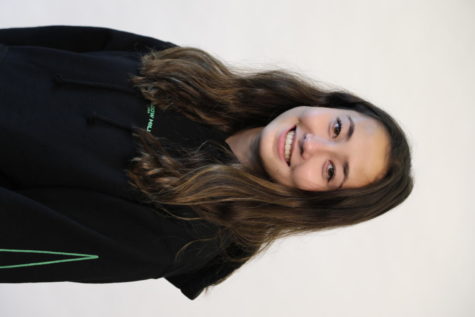
Number of years in The Coat of Arms: 3
Favorite aspect of journalism: writing about topics I'm passionate about, like music.
Interests outside of school: working at Tin Pot Creamery, baking, and dancing.
Class of 2023
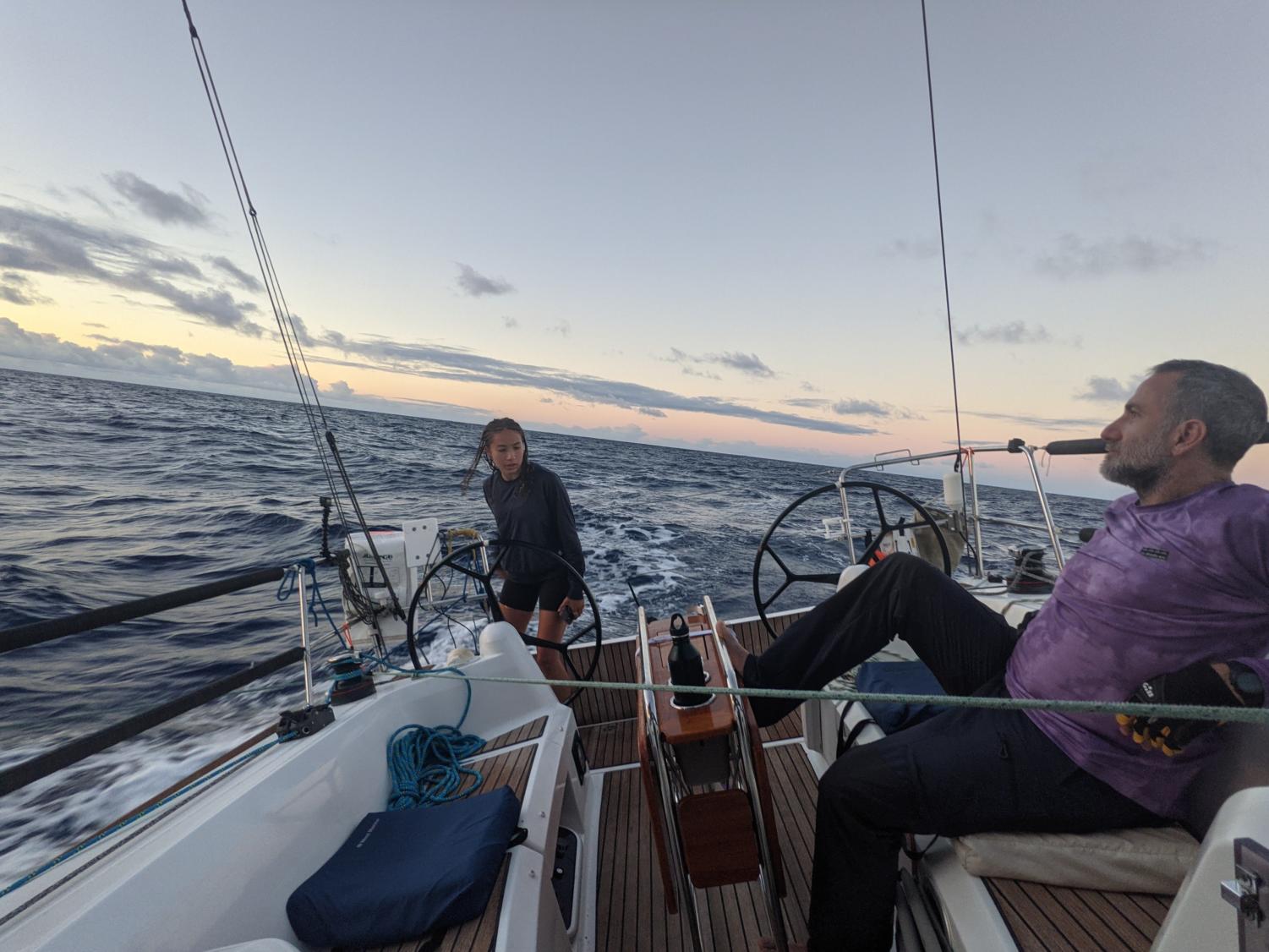

September 20, 2022
While many Menlo families celebrated American independence on July 4 this year with barbecues and fireworks, senior William Floyd instead set sail on his family’s boat on a 3,000 mile journey across the Pacific Ocean. This journey would not entail leisurely activities, either; Floyd was participating in his first Pacific Cup, a sailing race from San Francisco to Hawaii.
Despite this being Floyd’s first competitive race, he is no beginner sailor. “I’ve been sailing all my life,” Floyd said. Floyd normally sails about once a month, but, in preparation for the Pacific Cup, he sailed much more frequently on his family’s boat, Sacajawea. Sacajawea is approximately 34 feet long and 10 feet wide.
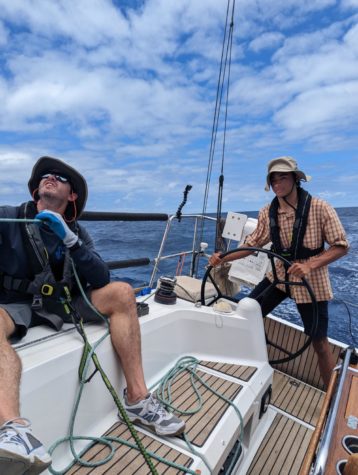
Before the race actually began, though, Floyd and his family had to prepare about two weeks’ worth of food and water to take on the boat. According to Floyd, it was easiest to bring dry food that could be mixed with water, such as oatmeal. “We bought a ton of different kinds of freeze dried food, like chicken alfredo and mac and cheese,” he said. “Our boat came with a 54 gallon tank, but it wasn’t enough. So we had to buy a bunch of extra [water storage] to have around.”
In addition to packing these essentials, Floyd and his family also prepared for the race by inputting polars, or statistics, into an online navigating application, which then predicted the most ideal sailing course for them to follow to Hawaii. “Polars are basically how fast your boat is, theoretically, at certain angles to the wind,” Floyd said. “You can put that into computer models that take into account the weather forecasts, and then they tell you the fastest way to get [to Hawaii].”
However, these predictions are not completely accurate, since wind speed and weather can change at any given moment. “The computers only provide an idealistic version [of where to sail], and we didn’t end up sailing the boat as fast as we had entered into the models,” Floyd said. Even once Floyd and his family were sailing, they still had a computer and satellite on Sacajawea, allowing them to constantly download updated forecasts.
Another unanticipated problem struck while out in the Pacific: Floyd became seasick. Floyd did not take motion sickness medications, since they have not worked successfully for him in the past. These medicines also often contain a side effect of drowsiness, which would have counteracted his need to stay awake and work daily sailing shifts.
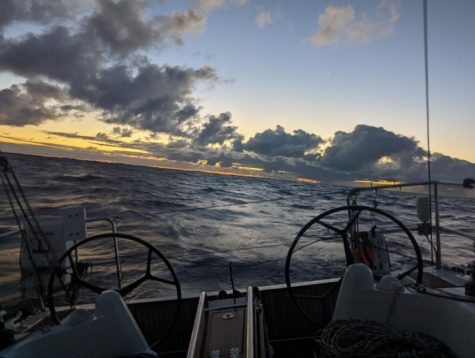
Floyd and the rest of the crew divided each day of the race into rotating shifts. “In the day, we would have six-hour shifts, and at night, we would have four-hour shifts,” he said. Floyd worked one of the two six-hour daytime shifts everyday, either from 6 a.m. to noon, or noon to 6 p.m. At night, he either worked either only one shift, from 10 p.m. to 2 a.m., or two shifts, from 6-10 p.m., and 2-6 a.m. Responsibilities during a shift included staying up to date with weather and otherwise ensuring Sacajawea was sailing in the proper direction without any problems.
Floyd also used his boat’s autopilot, which made working shifts more enjoyable. “You can either tell [autopilot] to steer to a magnetic heading or an angle to the wind,” Floyd said. “So, when the autopilot was on, you could kind of just sit and do whatever.” However, according to Floyd, autopilot did not function as well when there were large ocean swells surrounding the boat or when nearby wind grew too strong. In these circumstances, manual steering was necessary.
About five or six days into the race, Sacajawea’s autopilot malfunctioned. “It refused to give us control of the boat for like two days,” Floyd said. “It refused to turn off.” In addition to the autopilot, several other parts of Floyd’s boat became damaged throughout the race. According to Floyd, their hydro generator would not cooperate, their mast became dented and both their spinnaker and whisker pole broke. “We also wore through the fabric in our main sail in like four different places by the end of [the race],” Floyd said.
Floyd believes the “main event” of the race was when several of their sails tore. On day 12 of sailing, the wind grew too strong for Sacajawea’s spinnaker. It wasn’t long before an entire side of the boat tilted towards the sea and the winds, causing water to start filling the boat’s surface. “My ankles were underwater. I had to like crawl up and scramble under the boom, which was basically the side of the boat at that point instead of the top,” Floyd said. “It was a disaster, but it was exciting.”
Even after they released all their sheets and depowered their sails, the boat still would not regain balance. Once the boat eventually settled, though, Floyd’s father and Bruins spent hours resewing their sails back together, which they’d had little previous experience in doing. “They became experts in sail repair,” he joked.

When Floyd was not on duty, he could be found either catching up on sleep, cooking or reading one of the eight books he packed with him. “Eight [books] weren’t enough,” Floyd said. “We had cell phones but there was no Internet, so I couldn’t do anything except read and write.” It would often take Floyd over 30 minutes to download simple emails and weather files.
Even though Floyd did not have much Internet access, he still had to use his satellite phone to interact with other sailors in the race on a daily basis. “Every morning at 8 a.m., we had to send in a position report with a quick little blurb on where we were and what was happening,” Floyd said. During the first segment of the race, access to position reports were delayed by four hours. According to Floyd, this ensured that nobody would gain a tactical advantage from tracking their competition. “Then, at some point, [delays] weren’t necessary, because we were all already spread out,” he said. “We also used our radio when other boats passed us, which was funny, because you wouldn’t expect to run into one another in the middle of the ocean.”
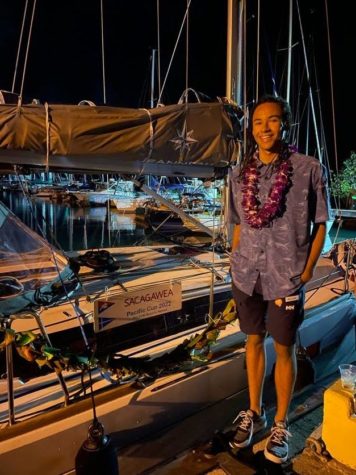
Sacajawea docked in Hawaii on July 22, 18 days after the race began. “In our division we got last place, but that’s with an asterisk next to it,” Floyd said. “There was a ‘finish by this point’ cutoff to place, so we were the last boat that got in before the cutoff.”
After the race, Floyd and his family cleaned Sacajawea for Bruins and two of his other friends to sail back to the Bay Area. This allowed Floyd to spend a full week enjoying the island before flying home. Floyd has no current plans to participate in the next Pacific Cup but definitely hopes to do so again.
One thing Floyd won’t forget from the Pacific Cup were the sunsets he witnessed every night. “It was almost kind of like the clouds were making a mosaic with the sunsets,” Floyd recalled fondly.

Number of years in The Coat of Arms: 3
Favorite aspect of journalism: writing about topics I'm passionate about, like music.
Interests outside of school: working at Tin Pot Creamery, baking, and dancing.
Class of 2023